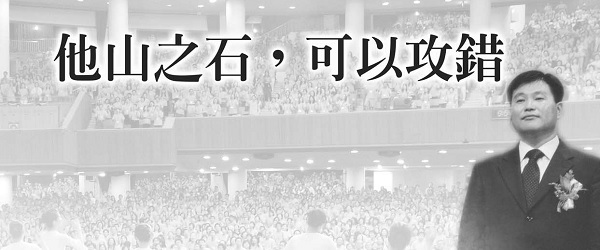A rock from another mountain can be used to attack the wrong one [Part 1]: Interview with Pastor Zhang Hanye of Taipei Full Gospel Church and Ezra Ministry Center
Interview/Weng Jingyu

As the Taiwan branch of the largest church in the world, please share what is the most valuable lesson for Taiwanese churches from your missionary experience in Korea?
The revival of Korean churches is closely related to missions. Since the 1960s, the number of Christians in South Korea has doubled almost every decade, from one million → two million → four million → eight million, to the current 12 million. Overseas missions drive an upsurge in evangelism in the country; just like the Yeouido Full Gospel Church, the largest church in the world, when the church is growing most rapidly, it is when missions to the world are most fervent. Almost every Korean church has missions to the Third World, especially China. It can be said that missions is the best strategy for church revival.
Many Korean churches have followed the "four, three, and three" strategy of some American churches: budgeting 40% for administration, 30% for personnel, and 30% for missions and charity work. The well-known Antioch Church in Jeonju City (located in the southwest of South Korea, one of the cities under the jurisdiction of North Jeolla Province) uses 70% for missionary purposes. Over the past ten years, the number of members has grown to more than 5,000. They still use the iron house left over from the US military as the auditorium, without air conditioning and heating; for the sake of missionary work, they are willing to bear any inconvenience.
During the Asian financial crisis in 2000, the U.S. dollar appreciated sharply, and Korean churches had to pay twice as much to support a missionary. Many people have proposed cutting missionary funding in half, but many churches still insist (such as the Korean Church). Other things can be saved, but only missionary work cannot be saved, because the situation of missionaries may be more difficult.
In contrast, Taiwan has not yet reached the goal of "one million believers and 30,000 missionaries" set in 2000 AD. Of course, the biggest problem is not money, but vision and burden. As long as the Taiwanese church understands the missionary vision and burden, no longer looks inward, and firmly believes that God will provide all needs. I really hope that all churches, regardless of denomination, can work together and grasp the key to revival.
Asia’s visit to Korea has entered its 20th year. Many Christians have come to Korea to observe and learn. According to your observation, what are their biggest changes and gains?
From one to two hundred people visiting Korea to the current number of more than 5,000, the brothers and sisters’ gains can be summarized in the following six aspects:
1. Personal prayers answered:When you come to Korea, you must put aside your busy schedules, not be hindered by time and space, and be able to concentrate on seeking God. Some people were healed of their illnesses, and some became pregnant after years of infertility. Over the years, Taiwanese churches have gradually accepted the work of the Holy Spirit, but there are still many conservative churches. Most of the brothers and sisters who visit Korea hope to seek God together through everyone and receive the anointing and filling of the Holy Spirit.
2. The whole family experiences spiritual renewal:During the visit to the Holy Assembly in Korea, many brought their families and dependents. Broken relationships were restored, rebellious children started studying hard, and the whole family experienced spiritual renewal and was greatly blessed.
3. The church ignites the fire of prayer:The weakest thing about Taiwanese churches is the prayer meetings. Members are used to attending Sunday services, but very few attend prayer meetings. After arriving in Korea, some churches' prayer meetings were revived again, and some churches started a prayer movement from scratch.
4. The unity of pastors and members:After the pastor visited Korea, he became more committed, the brothers and sisters were greatly encouraged, and their persistence changed accordingly. The cold heart was stirred up again, and the burden of vision was once again established. In the past, I didn’t tithe or observe the Lord’s Day. Now that I have returned, I am willing to be the pastor’s helper and work together to build the church.
5. Regional joint ministry:It is amazing that many churches that have led delegations to Korea have gathered together to hold cross-church activities after returning, bringing about regional unity. Many churches have made great breakthroughs in terms of their membership. Take the Xindian Association for example. When they first participated in the visit to Korea, the number of members was six to seven hundred. In the past six years, the number of members has increased to 3,500. I believe that the Visiting Korea Association has played a certain role in this. role.
6. Links to overseas churches:In the past, it was only Hong Kong, but now there are also Chinese churches in Taiwan, Singapore, etc., all praying together. Nowadays, there are many kingdom connections and services that have been completed due to the visit to the Korea Holy Assembly.
What is the basic training for missionaries in the Korean Full Gospel Church? What advice would you give to young people who are interested in becoming international missionaries?
Taking the Yeouido Full Gospel Church as an example, there was no special training in the early days. Preachers often practiced in church service, and it was easier to adapt when sent overseas. In the later period, missionaries were sent out as soon as they graduated. They lacked practical pastoral experience and were full of problems.
So more than ten years ago, after graduating from seminary, missionaries had to undergo a six-month Pentecostal Missionary Training Institute (PMTC), five months of theoretical study, and a sixth month of short-term field missions. , to confirm whether it is the country that truly bears the burden. The mother church maintains a close relationship with all missionaries sent out; when they arrive in the mission country, they also receive the care, assistance and support of the missionaries.
The most important thing for a missionary is spiritual training, steady prayer, worship, Bible reading, and firm faith. Only by facing spiritual battles can they not be defeated. The second is language training. If the language is not good, it will be difficult to carry out missionary work, so at least two years should be devoted to learning the language.
Third, no matter which country you go to, you must love the local people, because all motivations are out of love. Missionaries should spend more time on short-term missions to various countries to explore the real needs of local people.
The Ezra Ministry Center of your church actively promotes the publication of spiritual books by pastors such as Zhao Yongji. What are your views and practices on Christian cultural mission?
Since the Korean Wave has become popular all over the world, many countries have taken a new look at South Korea. Through these excellent Korean dramas, we can better understand Korean people's sentiments. In TV series and movies produced by Christians, church or prayer content can often be seen, and many Korean entertainers are also Christians. Vietnam and South Korea originally had a lot of enmity, but even senior cadres of the Communist Party of Vietnam have said that they would like to visit South Korea. It can be seen that the explosive power of cultural mission is so great that it should not be underestimated!
Since the Pyongyang Great Revival in 1907, the churches in South Korea have been able to continue to revive for decades, which is closely related to written missionary work. Because literature missions is the channel through which the work of the Holy Spirit can be preserved! The influence of preaching is often limited by time and space, but written preaching is far-reaching; some people's faith grows precisely because of a book. No matter how well Pastor Zhao’s writing is written, pastors from other countries will not be able to understand it if it is limited to Korean.
Since the establishment of the Seoul Discourse Society in the 1970s, Yeouido Church has mainly published Pastor Cho’s sermons, special topics, or expository sermons, and there are hundreds of them to date. Since the Ezra Ministry Center was established in 1997 based on this vision, we have indeed seen many Taiwanese churches understand their pastoral views from the writings, which has promoted exchanges and learning. For Pastor Cho Yong-ki’s works, please visit: http://www.graceph.com/images/p41j.htm
Finally, do you have any valuable suggestions for the missionary work of the Chinese churches in North America?
Currently, among Asian American churches, the most revived church is the Korean church. There are several large Korean churches in San Francisco, such as Love Church, International Grace Church, Yongle Church, etc. They all have a lot of spiritual assets and are worthy of exchange and learning.
In recent years, there has been a boom in immigration from mainland China, and it is easier for them to put aside their political ideas or traditional religious baggage after arriving in the United States; we must seize the opportunity and lead people to believe in the Lord. However, without prayer and the power of the Holy Spirit, all human efforts are still in vain. I hope that the Chinese churches in North America can ignite the fire of prayer and the filling of the Holy Spirit by participating in the Holy Assembly. In 2009, you are welcome to search for "Visit Korea Holy Assembly" online to register. Although this year has passed, you can still refer to the website http://www.ncnc.us.

